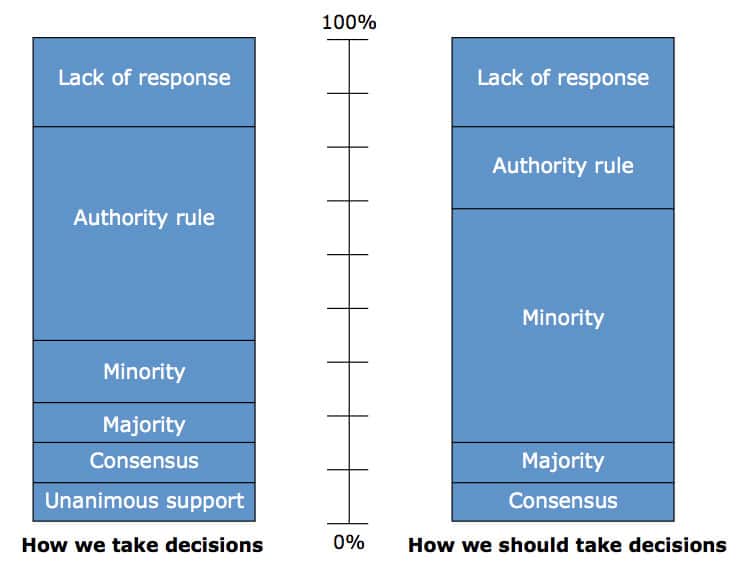Group Decision Making Analysis is a team building exercise that provides an opportunity for team members to discuss and agree how they can make effective decisions, using the appropriate decision making style for particular situations.
Unlike a lot of the tools and techniques on WorkshopBank it focuses on improving only 1 key process – how to make decisions in a better way.
Most groups and teams can improve decision making, don’t you think?
Objective
- To achieve faster, better group decision making within your team.
What Is It?
- It enables team members to discuss how decisions are currently taken, and to contrast this with how they wish them to be made in the future.
Why is it useful?
- The way decisions are made within a group often goes unquestioned, particularly if there are dominant personalities within the group.
- However, if an inappropriate decision-making style is used in a particular situation, there will be negative consequences e.g. people ‘nod’ the decision through, but don’t buy in to it, and therefore don’t support its implementation.
- This leads to both ineffective and inefficient decision making.
When Would You Use It?
- When you hear complaints from people that they are not getting enough done as a result of decisions being held up in the organization.
Resources Required
- 30 mins.
- Between 4 and 20 people.
- Copies of the blank Decision Style Analysis template for all participants.

You can download these templates for free at the bottom of the page
Process
- The Facilitator introduces the activity with a brief outline of the six decision-making styles:
- Lack of response
- Authority rule
- Minority
- Majority
- Consensus
- Unanimity (or Unanimous Consent)
- Each Participant takes a Decision Style Analysis template. The first rectangle represents how we make decisions today. The second represents how we should make decisions.
- The Participants then apportion percentages to the first rectangle according to: ‘How we make decisions’. For example, if they believe a quarter of all decisions are made due to unanimous consent then Unanimous Consent gets awarded 25% of the rectangle. And so on for the other 5 decision making styles.
- Then they complete the second in the same way according to: ‘How we should make decisions’ (see the example).
- The Group then compare their completed rectangles and the Facilitator initiates a discussion on the differences between their analyses and steps they can take to achieve a greater match between where we are now and where we want to get to.
Decision Making Styles
Lack of response
Brainstorm ideas – no discussion – no critical evaluation – until one emerges that is accepted by the group; all others are discarded or bypassed by simple lack of response.
Authority rule
Chairperson or leader makes the decision for the group, either with or without discussion. Group ‘buy-in’ is limited because the outcome is imposed.
Minority rule
Two or three dominant people ‘railroad’ the group into a decision. Scant opportunity for group to challenge and hence validate outcome. Often agreement by intimidation! An advantage could be that it may be highly productive to appoint a small number of experts from within the team to discuss and reach a decision on behalf of the wider team than it would be to involve everyone.
Majority rule
Formal voting or polling to identify the outcome most favored. Can promote coalitions of ‘winners’, and losers that feel disenfranchised by the process.
Consensus
Alternatives discussed until one emerges that is favored by most members whilst others express their support, grudgingly or otherwise! Dissenting members at least have their views heard and commit to live with it. A downside however is that it demands high levels of commitment, time, energy and maturity from those involved so should be saved for those situations where a consensus will reward the high investment.
Unanimity (or Unanimous Consent)
All group members agree totally on the course of action or outcome selected. Difficult and often unrealistic to attain with diverse groups.

Secret Sauce
- If you have a large group you might want to form smaller breakout groups of 4 for the discussion to see if they can achieve a mini-consensus before bringing the whole group back together.
- The group are likely to not see the difference between ‘Consensus’ and ‘Unanimous Consent’ and/or ‘Majority’ and ‘Consensus’. Ask them what they think the difference might be, before moving forward, so they agree a definition that works well for them in their situation.

